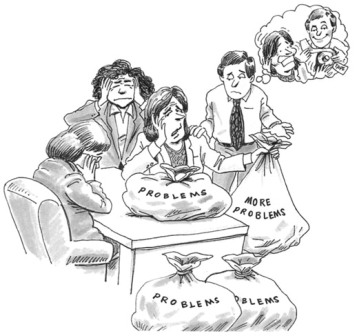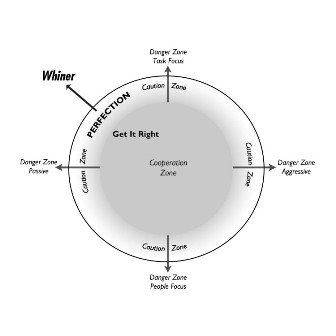
The Whiner

“It was terrible,” Cynthia whined.
Joann took a deep breath, looked up at Cynthia, and forced a smile. “Yes, terrible you said.”
Joann began doodling on the pad of paper in front of her. This was the fifth time Cynthia had interrupted her this morning. And if that wasn’t bad enough, Joann had 16 more in her department just like Cynthia. She had heard that the manager before her had taken an early retirement because she couldn’t stand these people any longer. Joann had mistakenly believed the other managers were kidding about that. Painfully, she had discovered they were not. It seemed that she couldn’t concentrate on any one item for longer than 10 minutes without someone whining about something. “How will I ever get any work done?” she thought to herself.
“Wow, Cynthia, that’s an awful shame about the box and the grill.” Joann thought that if she agreed with her, Cynthia would stop. She was wrong.
“You have no idea how awful it is!” said Cynthia with renewed enthusiasm. “Why ...,” and she started the whole story again, with new embellishments to amplify her pain.
These complaints were a complete waste of time. Joann just didn’t see the point of it. And as the whining drifted in and out of her consciousness, she began whining to herself: “Why do they have to act like this? Why is this happening to me?”
There are three different kinds of complaints that we all hear in the course of our lives: helpful, therapeutic, and obnoxious.
The helpful complainers draw attention to problems that ought to be addressed and offer options or solutions along with the complaints. This can actually help businesses, systems, and relationships to grow, develop, and improve. Most people with a problem, the silent majority, do not complain to the offending party. The few people who speak up about a problem while working to find a solution are a blessing to their coworkers, families, employers, and the companies they do business with.
Another type of complaining can be downright therapeutic. We all need to vent, to unload, to give voice to our frustrations once in a while. A little whining on occasion can actually help us unwind from the stress of modern living. Telling someone about your stress can provide a valuable release valve for otherwise-pent-up concerns and backed-up energy.
Wallowing in their worries and woe is the behavior of the Whiners. It has very little to do with releasing stress. Wallowing just goes on and on. Cynthia was this kind of complainer. She never offered solutions, and her complaints were not geared toward change of any kind.
As you look through the Lens of Understanding, you can begin to make some sense out of this difficult behavior. Negativity occurs on a spectrum, ranging from the helplessness of whining to the hopeless certainty of a No Person. Both behaviors emerge out of the intent to get it right. No People can see what could and should be, then look at what is, and when what is doesn’t measure up to what could and should be, they give up and become hopeless. The Whiners, on the other hand, become helpless, while hoping that someone else can close the gap. Perhaps that is why they let anyone in earshot know what’s wrong with everything.

Whiners may have a vague sense that events should be different from what they are, but they have no clue about how events ought to change. This leaves them utterly helpless to deal effectively with what they don’t like, and that’s why they come to you. In other words, if there’s a plan for their lives, they’re not in it! Because of this feeling of helplessness, Whiners are vocally less assertive when compared to No People. Three elements contribute to giving their voice that characteristic whining sound: the weight on their shoulders from carrying their burden of collected woe, which only grows heavier as they continue to find and collect problems; the effort required to talk about all that’s wrong when there’s nothing they can do about it anyway; and the feeling of futility, since you probably won’t offer any useful ideas or right the wrongs.
Expressions of negativity can be virulent, spreading like the flu through teams of people. Before you know it, everyone is doing it. If these behaviors become habits, morale and productivity are dragged down into the quicksand of inaction. Not to sound negative, but if you don’t deal with these behaviors, morale and productivity may never return.
You’d Better Adjust Your Attitude
Like Joann, people who deal with Whiners sometimes become Whiners themselves. This exponentially increases the agony of dealing with them as it becomes difficult to distinguish between whose complaints are whose.
There are four acts of desperation that only make the situation worse. We call them the Whiner Don’ts:
1. Don’t agree with Whiners. If you agree with them, it just encourages them to keep complaining.
2. Don’t disagree with them. If you do, they will feel compelled to repeat their problems.
3. Don’t try to solve their problems for them. You can’t.
4. Never ask them why they are complaining to you about their problems. They hear this as an invitation to start all over again from the beginning.
There are three attitudinal requirements that will help you deal with these problem people. We call them the Whiner Dos:
1. Do have patience with their impossible standards and seemingly endless negativity.
2. Do have compassion for the pitiful Whiners whose lives seem beyond their control.
3. Do have commitment to the lengthy process of getting them to focus on solutions.
The goal and strategy that you are about to learn for dealing with Whiners is also the first thing you try with negative No People.
Your Goal: Form a Problem-Solving Alliance
If you must deal with Whiners, your goal is to team up with them to form a problem-solving alliance (and if that doesn’t work, then your goal is to get them to go away!). The difference between problem solvers and Whiners is in the way they approach a problem: the problem solvers look at the specifics of a problem with an eye toward finding solutions; the Whiners look at the problem, feel helpless, and then generalize that the problem is worse than it actually is.
So the best you can do with people who are whining, and for the sake of everyone around them, is work with them to diminish their feelings of helplessness by helping them to identify solutions. Done consistently through time, this strategy can sometimes cure Whiners once and for all. As the feeling of helplessness diminishes, so does the need to whine.
Action Plan
Step 1. Listen for the Main Points. We know! The last activity you want to engage in when someone is whining to you is listening! Yet that’s just what you need to do with Whiners. We recommend that you listen with paper and pen in hand so you can write down the main points of the complaint. We make this recommendation for several reasons.
First, Whiners love this because it shows them that you are listening. They may even infer that you’re accepting delivery on the bag of woe and signing for it. Second, this will help you backtrack and clarify, which is the next step of this strategy. Last, by writing down the main points of the complaint, you’ll never have to listen to a complaint more than once because you can recognize it immediately if they begin to recycle the complaint!
Step 2. Interrupt and Get Specific. Take command of the conversation through a tactful interruption. Then ask clarification questions to get the specifics of the problem, because generalizations are rarely solvable. But be ready for generalization stacking.
When you ask, “What’s wrong?” They say, “Everything.”
If you then say, “But what specifically is wrong?” They say, “All of it.”
Ask when it happens and they say, “All the time.”
Ask who is doing it and the answer is, “Everybody.”
And of course in response to the question, “What have you tried?” he answer is “Everything.”
Be ready for it, because after three generalizations are thrown on the stack, your growing frustration with getting nowhere may tempt you to jump to offering a solution. Don’t do it. At this stage, your goal is simply to outlast them.
It is normal human behavior to generalize. You know how this works. If you stop at two or three red lights in a row, you say, “All the lights are red today.” If you meet two or three people in a bad mood, you say, “Everyone is in a bad mood today.” The same thing happens for Whiners and No People, but on a grander scale. So when asking questions of negative people, you may find it helpful to think of this as being on a sort of archeological dig. Buried under all those generalizations lies some truth. If you keep digging, even asking questions you’ve already asked, you will eventually hit something specific.
There will be times when Whiners are simply unable to get specific, because they’ve put the problems in their bag of woe without examining them first in detail. If that’s the case, then you can assign (if you outrank them) or suggest (if you don’t) that they go out and gather more information, with instructions to bring that information back to you at a specific time. This gives them something to look forward to, instead of leaving them in their helpless condition.
Step 3. Shift the Focus to Solutions. Once you begin to get specific about Whiners complaints they find themselves face-to-face with the specifics of a problem. Although you may know what should be done, don’t say it. Instead, ask them, “What do you want?”
For some Whiners, this simple question has the potential to move their mind in a direction it’s never gone before, and they will actually come up with a practical solution. You may find yourself wondering, at that point, why they didn’t just suggest the solution before. The answer is that they couldn’t do it before. Human beings can only pay attention to so much at any given moment in time. If their attention is locked into generalizations instead of specifics, solutions are nowhere to be found. But once attention gets refocused on the specifics of a problem, solving the problem becomes possible.
Their response to your inquiry may be a simple “I don’t know,” in which case you use the standard, “That’s OK. Guess, make something up. If you did know, what would it be?” type of response, and look at them expectantly.
Still other Whiners, upon pondering your question, may come up with a list of wants that is completely unrealistic. For example, if the Whiner says, “I’m doing the work of three people. I want three more people hired.”
You may have to say: “Yes, you are working hard. But we both know that Ebenezer isn’t going to hire three more people. So the question remains, what do you want?”
When a Whiner’s answers to your questions are impractical, absurd, or unlikely, it’s important that you provide a reality check. Tell it like it is, and inquire again: “Based on these facts, what do you want?”
If the Whiner comes up with a reasonable answer, then ask what the next steps are or should be to make the solution happen.
Step 4. Show Them the Future. When people have been feeling helpless, it is helpful to give them something to look forward to. If solving the problem they’ve brought to your attention turns out to be your responsibility, then you must keep Whiners informed about progress.
If the complaints are about other people, you can offer to help set up a meeting with the people about whom they are complaining. Or, you can ask them to track and document the problem in writing. With employees, coworkers, or family members, you can then schedule a time to get back together and discuss the information they’ve gathered.
For example you could say, “You obviously know more about this problem than I do. I recommend you track this problem for the next two weeks. Then come back to me with three possible solutions and a recommendation on such-and-such date. Then we’ll take our next step.”
Step 5. Draw the Line. If backtracking, clarifying, and asking for a direction has not produced the desired result and your Whiner refuses to think solutions, then drawing the line on the interaction is a necessity. But how you draw the line varies according to your relationship to the Whiner.
• If you are the manager of the Whiner, it is important to take control and draw the line firmly on whining, because negativity, perhaps more than any other behavior discussed in this book, can undermine and destroy morale and team spirit. You might say, “If you don’t want to talk solutions, that’s your decision. But I don’t want to hear any more complaining. And I don’t want you distracting the people around you by whining about problems to them. If it continues, I will be forced to ...” and then promise them specific negative consequences they will suffer if they continue to demoralize others.
• With a coworker or friend, drawing the line must be done more considerately: “Mary, our friendship is important to me, but there’s no point in complaining if nothing can be done. If you want to talk to me about solutions rather than just identifying problems, my door is open.”
Do not allow them to draw you back into the cycle with their “But ...” and “You don’t understand” and the like. Stonewall your Whiner by repeating the closing statement: “As I said, if you change your mind and come up with some solutions, let me know.”If they don’t get the message, add a little nonverbal communication by placing your hand on their shoulder and guiding them to the door, or turn around and walk away.
Great Moments in Difficult People History

The Trouble Book
We met Katherine at one of our seminars, and she told us she inherited 17 chronic Whiners. The previous manager took an early retirement due to illness and fatigue (she got sick and tired of dealing with those people). Katherine was determined not to let that happen to her. She created the Trouble Book. She instructed her team that if they had problems, they were not allowed to whine about them. Instead, they had to use the Trouble Book.
The instructions were simple, and they were posted by the book:
1. Enter your name and today’s date.
2. Write a complete description of the problem. [Get the specifics]
3. Suggest three possible solutions to the problem. (If there were no suggestions, Katherine wouldn’t read the complaint. She didn’t care if the suggestions were outrageous as long as there were three of them.) [Shift the focus to solutions]
4. The fourth column was for Katherine’s initials, which would indicate that she had read each complaint and the suggestions.
5. The last column was for follow-up. Katherine became the champion for their solutions in the hospital bureacracy, and she kept them up to date as to what she was doing about the problem and it’s ongoing status. [Show them the future]
After a while, people started noticing that their complaints were addressed and suggestions implemented. Their feelings of helplessness gradually disappeared, and when they encountered problems, they began to take the initiative rather than even bother with the Trouble Book. Katherine proudly told us, “They became an inheritance of 17 useful problem solvers.”
The Great Positive Wallpaper Caper
Joe was the manager of a state government office. He didn’t have one specific Whiner to deal with. He had numerous negative and whiny people who, on any given day, took turns demoralizing the office. The big generalizations that circulated his office were along these lines: “This is government,” “Nothing ever changes,” and “Nobody listens to our recommendations anyway.”
Joe decided that disproving those generalizations could be the solution to their attitudinal problems. So Joe took a page from a flip chart and put it on the wall, and he labeled it “Things Changing for the Better.” For the next several weeks, whenever he implemented a suggestion, he wrote it on the chart. In three weeks’ time, the page filled with evidence of change, so he left that one on the wall and put up another piece of paper next to it. He continued to list changes for the better as they occurred. Two pages became four, which became eight, until the walls were literally wallpapered with changes.
Still, the biggest change was one that wasn’t written on the wall. The attitude in the office changed. People saw that they weren’t helpless and that change for the better does occur—even in government! Instead of noticing where the glass was half empty, people began to see where it was filling. The helplessness that had once plagued their operation gave way to high morale and innovations.

Quick Summary
When Someone Becomes a Whiner
Your Goal: Form a Problem-Solving Alliance
ACTION PLAN
1. Listen for the main points.
2. Interrupt and get specific.
3. Shift the focus to solutions.
4. Show them the future.
5. Draw the line.